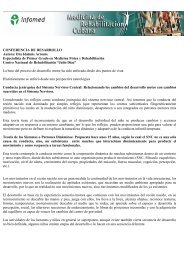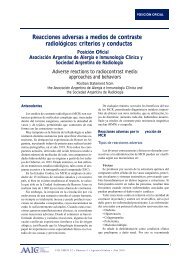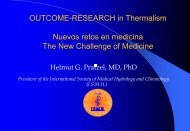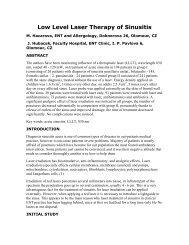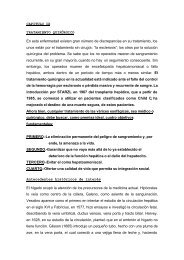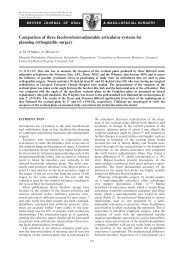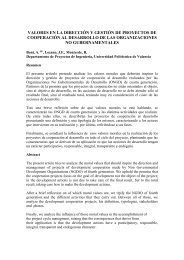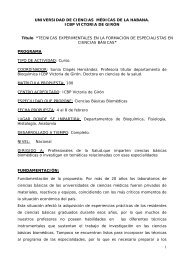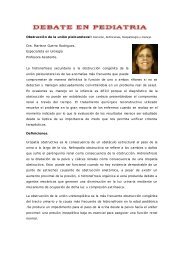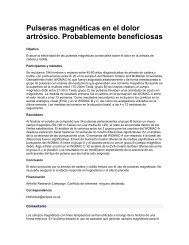pharmacology of medicinal plants and natural products
pharmacology of medicinal plants and natural products
pharmacology of medicinal plants and natural products
You also want an ePaper? Increase the reach of your titles
YUMPU automatically turns print PDFs into web optimized ePapers that Google loves.
MEDICINAL PLANTS (NATURAL PRDUCTS)<br />
S103<br />
normal rats. All the results suggest that the mechanism<br />
<strong>of</strong> action <strong>of</strong> Momordia charantia could be partly<br />
attributed to increased glucose utilisation in the liver<br />
rather than an insulin secretion effect 223 .<br />
19.3. Edible oils<br />
Ghafoorunissa et al, 224 studied the effects <strong>of</strong> the substitution<br />
<strong>of</strong> palmolein oil for ground nut oil on selected<br />
cardiovascular risk factors <strong>and</strong> membrane functions<br />
in middle aged subjects. The effects were essentially<br />
similar with both treatment regimes. This study indicates<br />
that palm oil may not produce the deleterious<br />
effects associated with saturated fatty acids 225 . The<br />
author further explained that the tocols present in<br />
palm oil are <strong>natural</strong> biological anti-oxidants <strong>and</strong> can<br />
therefore augment the anti-oxidant potential <strong>of</strong> Indian<br />
diets. Also, red palm oil is the richest <strong>natural</strong> source<br />
<strong>of</strong> carotenes (especially beta-carotene) which are<br />
powerful biological anti-oxidants <strong>and</strong> hence, red palm<br />
oil can be used to prevent vitamin A deficiency which<br />
is widespread in India.<br />
A study conducted by Kumar, 226 ruled out the association<br />
<strong>of</strong> increased incidence <strong>of</strong> coronary heart disease<br />
(CHD) with the high consumption <strong>of</strong> coconut<br />
<strong>and</strong> coconut oil in Kerala. Since their consumption <strong>of</strong><br />
coconut <strong>and</strong> coconut oil <strong>and</strong> saturated fats <strong>and</strong> found<br />
that both groups did not differ in 32 CHD patients<br />
<strong>and</strong> 16 age <strong>and</strong> sex matched healthy controls.<br />
19.4. Turmeric (Curcuma longa)<br />
Curcumin (from Curcuma longa) protected against<br />
decrease in heart rate <strong>and</strong> blood pressure <strong>and</strong> biochemical<br />
changes in cat heart after coronary artery<br />
ligation. It also prevented the elevation <strong>of</strong> MDA content<br />
<strong>and</strong> lactate dehydrogenase release in the ischaemic<br />
zone. However, it did not prevent the increase in<br />
myeloperoxidase activity, indicating that curcumin<br />
protects against ischaemia induced changes by increasing<br />
the antioxidant defense mechanisms 227 .<br />
Deshp<strong>and</strong>e et al, 228 demonstrated that both pre-treatment<br />
as well as concurrent treatment <strong>of</strong> turmeric<br />
extract in CCl 4<br />
treated rats caused a reduction in<br />
cholesterol, bilirubin, SGOT, SGPT <strong>and</strong> alkaline phosphatase<br />
activity; concurrent treatment <strong>of</strong>fering more<br />
significant protection.<br />
The anti-mutagenic activity <strong>of</strong> Curcumin has already<br />
been described under the section ‘Anti-mutagenic<br />
<strong>plants</strong>’.<br />
19.5. Fenugreek (Trigonella foenum graecum)<br />
Administration <strong>of</strong> unroasted <strong>and</strong> roasted powdered<br />
forms <strong>of</strong> seeds <strong>of</strong> Trigonella foenum graecum (fenugreek)<br />
to alloxan induced diabetic rats produced a<br />
significant fall in various serum lipids like total cholesterol,<br />
LDL <strong>and</strong> VLDL cholesterol <strong>and</strong> triglycerides<br />
in normal rats <strong>and</strong> in addition, increased HDL cholesterol<br />
in diabetic rats 229 .<br />
19.6. Curry leaf (Murraya Koenigii) <strong>and</strong> Mustard<br />
(Brassica juncea)<br />
Whole curry leaf (Murraya Koenigii) <strong>and</strong> mustard<br />
(Brassica juncea) fed to rats at doses equal to normal<br />
human intake did not cause any adverse effect<br />
on food efficiency ratio, haematological parameters,<br />
liver <strong>and</strong> renal function tests, fibrin level <strong>and</strong><br />
glycosylated haemoglobin. No histopathological<br />
changes were observed in the liver 230 . Both, <strong>plants</strong><br />
showed significant hypoglycemic action in rats. There<br />
was an increase in the concentration <strong>of</strong> hepatic glycogen<br />
<strong>and</strong> glycogenesis <strong>and</strong> a decrease in glycogenolysis<br />
<strong>and</strong> gluconeogenesis 231 .<br />
The status <strong>of</strong> lipid peroxidation was investigated in<br />
rats fed Murraya Koenigii <strong>and</strong> Brassica juncea. Concentration<br />
<strong>of</strong> malondialdehyde showed a significant<br />
decrease, while hydroperoxides <strong>and</strong> conjugated<br />
dienes were significantly increased in liver <strong>and</strong> heart<br />
<strong>of</strong> both the experimental groups. Superoxide<br />
dismutase <strong>and</strong> catalase activity was found to be increased<br />
in liver <strong>and</strong> heart <strong>of</strong> both the spices administered<br />
groups. Glutathione levels in liver, heart <strong>and</strong><br />
kidney were lowered in rats administered these species.<br />
Glutathione reductase, glutathione peroxidase<br />
<strong>and</strong> glutathione S-transferase activity showed a sharp<br />
increase in the experimental group compared to the<br />
controls 232 .<br />
19.7. Mint leaf (Mentha spicata)<br />
Mint leaf has been shown to have significant stimulatory<br />
effect on the lipase activity <strong>of</strong> pancreas <strong>and</strong><br />
intestinal mucosa in rats. It also stimulated intestinal<br />
amylase activity 233 . It, however, had no effect on bile<br />
secretion <strong>and</strong> its composition.<br />
19.8. Onion (Allium cepa)<br />
Augusti 234 in his review on the therapeutic values <strong>of</strong><br />
onion (Allium cepa) <strong>and</strong> garlic (Allium sativum), has<br />
discussed the presence <strong>of</strong> many sulfur containing




